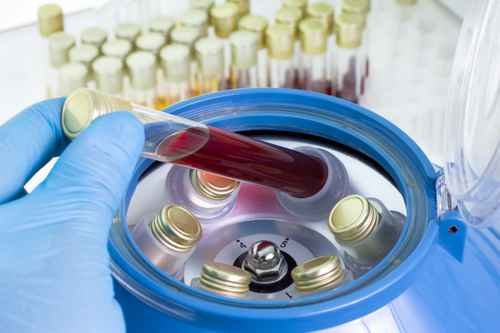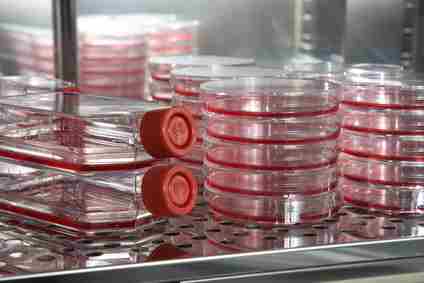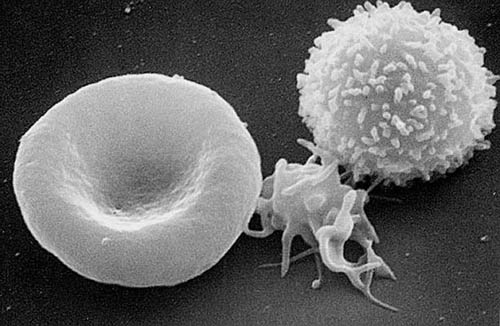Working Group ‒ a Portrait:
Renal Molecular Physiology at the
Medical University of Innsbruck
The working group investigates questions regarding the biochemistry and physiology of the kidney and mostly works with epitheliala cell and tissue cultures. A further focus is on replacement methods for animal experiments. We would like to emphasise a human-specific method with which the cell physiologist Prof. Gstraunthaler and his team intend to replace foetalb bovine (FBS), a component of almost all nutrient media for cell cultures.

View of Innsbruck.
Source: Scirocco340, Fotolia.com
Problem
Whole blood comprises 45% blood cells and 55% plasma. This plasma is made up of clotting factors and the so-called serum. If one removes the cells by centrifuge and precipitates the clotting factors out of the blood, one obtains the substance that plays an important part in cell culture – the serum.
Serum, mostly FBS, is used as an additive in all kinds of cell culture media. However, despite the fact that that it has been used worldwide for decades, its precise composition is still not known in all its details. Scientists only know that its use is successful (the desired cells grow), but they do not know why. Nonetheless, it is used comprehensively and everywhere. 
Centrifuging separates the whole blood into plasma and blood cells. The clotting factors that are not needed are then precipitated out to obtain the valuable serum.
Photo: Angellodeco, Fotolia.com
Until now defined cell culture media have been the standard media for cultivating animal and human cells. However, the primary cells or cell lines must also be “encouraged” to divide. This is done via a not yet fully understood interaction between hormones and growth factors in FBS that is added to the basal medium1. Thus with the serum an undefined mixture of biologically active substances is introduced to a defined culture medium, explains Prof. Gstraunthaler.
Tragically, foetal calf serum is usually obtained from animals: Each year, serum is taken from millions of bovine foetuses worldwide, according to Prof. Gstraunthaler approximately 2 million bovine foetuses per year. The animals are a by-product from factory farming, as millions of pregnant cows are slaughtered. The cow is stunned with a bolt gun and then killed by bleeding2 ‒ often hanging by one leg. If a pregnant animal is discovered on the slaughterhouse disassembly line, it is separated, the uterus and the unopened amniotic sac are removed from the mother’s skeleton and a thick needle is inserted without anaesthesia between the ribs into the foetal calf’s still-beating heart approximately half a litre of blood per animal is extracted3. This delivers one million litres of foetal bovine serum Kälberserum4. A few years ago, racketeers blended serum from different countries in order to maximise their profits3, 4, 5. The use of foetal calf serum poses a number of disadvantages. Sera may contain toxic substances (e.g. environmental toxins), bacterial toxins (endotoxins)c and undesired microorganisms such as bacteria (including mycoplasmad) viruses or prions. The biotech companies selling serum guarantee that the products are ultrafiltered or sterilised and tested for endotoxins. However, since mycoplasma and viruses can easily pass through cellulose and polyvinyl filter with 0.45 micron pores, depending on the type of sterile filtration, contamination cannot be ruled out completely6. Although the Fraunhofer Institute for Mechanics of Materials in Halle has developed high precision aluminium oxide filter membranes with pore diameters of 15-450 nanometres, which can stop the smallest virus particles, there are drawbacks. Seasonal and geographical fluctuations in the qualitative and quantitative composition occur in single serum batches. Therefore, each batch must be retested with regard to its growth-promoting properties, causing additional work and expenses after the scientists have already purchased the expensive serum.

Serum is used as a supplement in all kinds of cell cultures.
Photo: Sven Hoppe, Fotolia.com
The industry has also not yet been able to develop chemically defined culture media that are equivalent to foetal bovine serum in all respects (mainly because so far not all of the components of FBS have been identified)4. Scientists estimate that foetal calf serum contains nearly 1,000 substances8. Recent proteomef and metabolomeg studies assume that about 1,800 different proteins and more than 4,000 metabolites are contained in the serum9,10.
Prof. Gstraunthaler has spent his life as a researcher analysing many or the most important substances and has published his findings in his book. They are published in his book “Zell- und Gewebekultur” (Cell and Tissue Culture)6.
Conventional cultured stem cells unsuitable for clinical use
In order to maintain stem cells in an undifferentiated state, or to retain their pluripotency, embryonic stem cell lines are stem cells are currently still grown on media containing serum, and on feeder layersh comprising inactivated mouse fibroblastsi. The cells thus cultured have not been approved by the American Food and Drug Administration for therapeutic use, because they are not classified as human transplant tissue, but rather as xenografts. The reason for this is the risk of transmission of xenobiotic pathogens from mice (such as viruses) or animal proteins via the culture to the human stem cells, according to Prof. Gstraunthaler.
Currently existing human stem cell lines incorporate N-glycolylneuramic acid (Neu5Gc) into the cell membrane, a substance that only occurs in animals, Prof. Gstraunthaler explains. Neu5Gc derives from the foetal bovine serum in the culture medium, is resorbed by the human stem cells and stored as a sialic acid residue. If such cells were to be transplanted, the recipient immune system would immediately attack the cells aggressively ‒ a risky endeavour. It follows that a stem cell therapy cannot be developed without human-specific, serum-free media, thus all previous research belongs to the area of pure fundamental research, and all announcements of possible therapeutic uses are wishful thinking. (Neu5Gc is also discussed in the context of a potential promotion of the development of cancer by high red meat consumption9).
What does foetal bovine serum contain?
Animal sera contains serum proteins such as immunoglobulins, transport proteins, adhesion factors, enzymes and hormones, also growth factors and cytokines, fatty acids, lipids, vitamins, trace elements, carbohydrates and amino acids6.
During the past 30 years, a number of chemically defined serum-free media have been developed for several cell types. Various cell systems can also be ordered for professional use from companies for laboratory supplies, such as PAN-Biotech or Biochrom. PAN-Biotech, for instance, offers serum- free systems for embryonic stem cells from mice or humans, for human induced pluripotent stem cellsj, for toxicological studies with the Embryonic Stem cell Test (EST) or human mesenchymalk stem cells. However, Prof. Gstraunthaler criticises that the exact composition is not known9. As a trade secret, it is not disclosed by the companies. The formulation is only provided in exceptional cases, for instance for the serum-free medium UltraCULTURE™11.
Despite many innovative starting points and the development of serum-free media for a multitude of cells, the addition of foetal bovine serum remains the method of choice in cell cultures. There are many reasons for this: first of all, the results are comparable, insofar as all researchers use serum. Second, there is not an alternative for every cell culture, but rather so far only for comparatively few. Third, it takes times and money to adapt a new serum-free medium to its cell types, so that it can repeatedly deliver reliable and reproducible results. During which six months can easily pass; companies with defined delivery schedules or scientists with limited funding periods cannot afford to experiment.
Prof. Gstraunthaler has spent years searching for alternatives to foetal bovine serum. In the course of his work, he has developed a new media supplement using human platelets (thrombocytes). Their composition has not yet been fully determined, but they can be used for supplying human cell cultures exclusively with human growth factors.
The role of platelets
Platelets themselves have no cell nucleus, as they are fragments of cytoplasm derived from precursor cells, the megakaryocytes. Each of these largest bone marrow cells produces about 1000 platelets9. The platelets receive from these cells the messenger RNA, which allows them to produce the proteins necessary for their own viability. In their resting state platelets are small, disc-shaped cells 1-2 micrometres in diameter1. When they are activated, they contract and form long pseudopodia in all directions (see the following photo, middle), which serve to close the wound in case of injury. 
From left to right: Erythrocyte (red blood cell), activated thrombocyte (platelet) with fibrinogen fibrils, leukocyte (white blood cell).
Photo: E. Rulez
Thrombocytes possess mitochondria, lysosomesl, peroxysomesm and storage granules (alpha granules and electron-dense granules)1. In the alpha granules, they store a number of factors, which they release when activated. These substances play a decisive part in haemostasis and the subsequent tissue repair. They cause the vessels to contract so that the body can avoid severe blood loss as far as possible (serotonin). Other substances help the platelets to find a wound in the first place and to aggregate and close the wound (thrombospondin and fibrinogen). They use fibronectin and the so-called von Willebrand factor to aggregate the platelets. However, especially the clotting factors such as fibrinogen can be disadvantageous in a cell culture and can cause the cells to aggregate in the culture via fibrin fibrils. Fibrin formation can be prevented with heparin, but that introduces heparin residues to the cell culture and the influence of this substance on cultured cells has not yet been sufficiently studied1.
Prof. Gstraunthaler has therefore developed a different method for removing the clotting factors and isolating the desired growth factors (e.g. platelet-derived growth factor = PDGF) for use in the cell culture. First of all, only platelets derived by cell separators (apheresis) for donor platelets are used12. The donor platelets are washed, resuspended in a physiological saline solution and lysed in a simple freeze-and-thaw process.
The growth factors
The factors that promote growth and cell division are PDGF (platelet derived growth factor), EGF (epithelial growth factor), FGF (fibroblast growth factor), TGF-β (transforming growth factor- β) and VEGF (vascular endothelial growth factor), which are of particular importance for human cell cultures. PDGF comprises four different isoforms and is in terms of quantity the biggest factor in the alpha granules, which strongly promote cell division11. Mitogenn leads to cell proliferationo, cell migration, tissue repair and angiogenesisp. A multitude of cell types has successfully been tested: various renal epithelial cells, cartilage cells, corneal cells, leukaemia cells. Both cell lines and primary cellsq grew with the new method1.
In tests conducted by the working group, adult stem cellsr from liposuction (adipose-derived stem cells, ADSC) were successfully cultured with the new thrombocyte extracts as a replacement serum. Under these conditions, the scientists are able to maintain the cells in their undifferentiated, oligopotentt status. ADSC can also achieve almost the same proliferation rates with the platelet lysates as in serum conditions13.
It could also be shown that the cells also keep their potential for differentiation, in that they developed to osteoblasts (bone-building cells), fat cells and cartilage cells14.
Practical: a database for serum-free media
In 2009, some scientists wanted to use the database Goodcellculture to provide other scientists with an overview of serum-free media and the products of various manufacturers. They developed a database and a search engine that could be used for searching for cell lines, media or cell lines adapted to serum-free media. The goal was to quickly find the necessary information in order to find the right serum-free medium or a suitable cell. Unfortunately, when funding ended, the project was not continued.
Summary:
There is an alternative to using foetal bovine serum, made from human platelets (thrombocytes). Prof. Gstraunthaler, but also other research groups, were repeatedly able to prove that the replacement method is suitable for maintaining stem cells in an undifferentiated state or for stimulating differentiation into the relevant cell types. This has been shown for mesenchymal stem cellsk, but also for a variety of other cell types.
The potential of platelet lysates should be tested on further culture systems
This requires sufficient funding. In light of the potential of future stem cell therapies, stem cell research should have a vested medical interest in preventing storage of sialic acid residues from other species in the cells and subsequent immune responses caused by differences between species. This meaningful research should be provided with sufficient resources. The industry must also make a contribution. There should be no stonewalling when it comes to what individual components are contained in particular media. After all, only good, reproducible research leads to new orders from the companies.
InVitro+Jobs interviewed Prof. Gstraunthaler on the development of serum-free media from human platelet lysates.
InVitro+Jobs: Your field of work is the physiology of the kidney: What led to you developing an alternative to foetal bovine serum?
Prof. Gstraunthaler: The reasons resulted from our study of renal epithelial cell cultures as alternatives to animal testing (in vitro nephrotoxicity tests).
InVitro+Jobs: Many people must already have thought of developing such an alternative. Why exactly has your idea been successful?
Prof. Gstraunthaler: Of course others already had that idea! We weren’t the only ones! The use of platelet-derived growth factors for bone augmentation has been known for a long time in the jaw surgery and orthopaedics. It was only a matter of time before these findings were transferred to the field of cell culture.
InVitro+Jobs: What is the difference between serum from bovine foetuses and humans?
Prof. Gstraunthaler: From the perspective of physiological functions, there is no difference between blood, plasma or serum of humans and animals. Calf serum contains foreign particles, i.e. animal proteins, which may be crucial in human cell cultures.
InVitro+Jobs: Shouldn’t blood also be taken from umbilical cords? Why isn’t it needed?
Prof. Gstraunthaler: No, absolutely not! The collection of umbilical cord blood immediately after birth is a big ethical problem and requires the parents’ informed consent. Secondly, I think that the amount that can be obtained is too small. And thirdly: Why? With expired donor platelets from blood banks we have a proper, clinically tested starting product. Concentrate bags of donor platelets have a lifespan of 5 days. After that, they can no longer be used for therapeutic purposes and have to be disposed of as medical waste. However, they are still ideal for extract preparation and isolating human platelet growth factors.
InVitro+Jobs: In your proof-of-concept study you have already shown that human platelet-derived growth factors are very suitable for culturing mesenchymal stem cells.
Prof. Gstraunthaler: Yes, but as I said before, other groups have also shown this. As a scientist and basic researcher I am always happy when others are able to confirm my research results, and vice versa, when I can reproduce the results of others.
InVitro+Jobs: At what stage of development you are at the moment?
Prof. Gstraunthaler: Well, the first studies have been completed and published. Thus our results and findings are present in the scientific community and have already been cited. But there is still much to do: for example, the expansion to other cell lines, long-term studies, standardisation of the lysates and GMP-compliant production, which has already been tackled by other groups.
InVitro+Jobs: So far, nobody really knows exactly what is in calf serum. Estimates speak of up to 1,000 different components. Nonetheless it is still used worldwide. What made it difficult to determine the component substances in recent decades? What methods do you use to determine them?
Prof. Gstraunthaler: The classical hormones in serum, such as insulin, thyroid hormones or steroids, and enzyme activities (LDH, GOT, GPT) are easy to detect. More difficult is the detection of highly species-specific growth factors, as there are no cattle-specific ELISAu. With modern mass spectrometry methods you receive a flood of data, but identifying the key growth and attachment factors is like the proverbial search for a needle in a haystack.
InVitro+Jobs: You write that the effect of heparin as a fibrin inhibitor on cell cultures has not yet been analysed in detail. Am I correct in understanding that you use a different salt solution instead of heparin. If so, what kind of salt solution do you use?
Prof. Gstraunthaler: It’s slightly different to that: In contrast to the frequently used “platelet-rich plasma” (PRP), in which the platelets are activated in anti-coagulatedv plasma, in our method platelets are washed, resuspended in saline and then lysed. Therefore, all plasma proteins ‒ but also all coagulation factors including fibrinogen ‒ are diluted sufficiently to prevent clotting or fibrin formation. Added heparin is thus no longer necessary.
InVitro+Jobs: Both www.goodcellculture.org and www.goodcellculture.com no longer exist. Is the idea of a freely accessible database dead?
Prof. Gstraunthaler: Not as such, but the ongoing maintenance of such comprehensive databases and their regular updating are very complicated and cost money. We would need specialists trained in the field of IT and web programming as well as in cell biology and cell culture. Furthermore, it is almost impossible to have an overview of the amount of newly developed commercial serum-free media. On the other hand, it must be said that the homepages of the respective companies are sometimes very informative and facilitate the search for serum-free media. What is missing, however, is the direct comparison – but this is not easy, because data on the composition of the media are usually not available, or are not disclosed by the companies.
InVitro+Jobs: Can students submit an application to you for a doctoral thesis in the field?
Prof. Gstraunthaler: Unfortunately, I am currently without a relevant project funding, thus I am not able to finance doctoral students or their research work.
InVitro+Jobs: If there is a risk posed by the sialic acid residues to the stem cell therapy: Shouldn’t be considerable interest in your serum-free media? Couldn’t your research be funded within the research focus “Regenerative Medicine”?
Prof. Gstraunthaler: Yes, that would certainly be a good approach to initiate a research alliance of all working groups active in this field. That could allow fully humanised culture systems for future clinical applications of stem cells to be developed collaboratively.
Literature:
1 Caroline Rauch, Elisabeth Feifel, Eva-Maria Amann, Hans Peter Spötl, Harald Schennach, Walter Pfaller & Gerhard Gstraunthaler (2011): Alternatives to the Use of Fetal Bovine Serum: Human Platelet Lysates as a Serum Substitute in Cell Culture Media. ALTEX 28: 305-316. http://www.altex.ch/All-issues/Issue.50.html?iid=128&aid=4
2 Hilsenbeck, E. M. (2007): Untersuchungen zur Entblutezeit bei Rindern nach Bolzenschußbetäubung. Dissertation at the Faculty of Veterinary Medicine,
Ludwig-Maximilians-Universität München (LMU Munich).
http://webcache.googleusercontent.com/search?q=cache:YEVF7Syx2cgJ:edoc.ub.uni-muenchen.de/6897/1/Hilsenbeck_Eva_Maria.pdf+Bolzenschuss+%2B+Fehlbet%C3%A4ubung&hl=de&ct=clnk&cd=13&gl=at&lr=lang_de
3 http://www.tagesschau.de/inland/kaelberserum-101.html
4 http://www.laborjournal.de/editorials/770.lasso
5 http://www.sueddeutsche.de/wissen/pharmaindustrie-das-schmutzige-geschaeft-mit-dem-blut-ungeborener-kaelber-1.2602820
6 Gstraunthaler, G. & Lindl, T. (2013): Zell- und Gewebekultur. Allgemeine Grundlagen und spezielle Anwendungen. 7th edition, Springer Spektrum Verlag Heidelberg. http://www.springer.com/de/book/9783642331121
7 Chandana Tekkatte, Gency Ponrose Gunasingh, K.M. Cherian & Kavitha Sankaranarayanan (2011): “Humanized” Stem Cell Culture Techniques: The Animal Serum Controversy. Review, SAGE-Hindawi Access to Research Stem Cells International, Article ID 504723,
doi:10.4061/2011/504723
8 Schrödel, A. (2007): Die Rolle des fetalen Kälberserums in Zellkulturmedien. Biol. Unserer Zeit 5/37, Seite 289. Wiley-VCH-Verlag.
9 Gstraunthaler, G. (2014): A Severe Case of Fraudulent Blending of Fetal Bovine Serum Strengthens the Case for Serum-free Cell and Tissue Culture Applications. ATLA 42: 207-209.
10 Gerhard Gstraunthaler, Toni Lindl & Jan van der Valk (2013): A plea to reduce or replace fetal bovine serum in cell culture media. Cytotechnology 65: 791–793. DOI 10.1007/s10616-013-9633-8
11 https://www.sartorius.de/de/product/product-detail/be12-725f/
12 http://www.transfusionsmedizin.ukw.de/studenten/hauptvorlesung/herstellung-indikation-tks/herstellung.html
13 Caroline Rauch, Jaqueline Wechselberger, Elisabeth Feifel and Gerhard Gstraunthaler (2014): Human Platelet Lysates Successfully Replace Fetal Bovine Serum in Adipose-Derived Adult Stem Cell Culture. Journal of Advanced Biotechnology and Bioengineering 2: 1-11. http://www.synergypublishers.com/downloads/jabbv2n1a1/
14 Caroline Rauch, Elisabeth Feifel, Angelika Flörl, Kristian Pfaller & Gerhard Gstraunthaler (2014): Human Platelet Lysates Promote the Differentiation Potential of Adipose-Derived Adult Stem Cell Cultures. Journal of Advanced Biotechnology and Bioengineering 2: 39-48. http://www.synergypublishers.com/downloads/jabbv2n2a1/
15 Annie N. Samraj, Oliver M. T. Pearce, Heinz Läubli, Alyssa N. Crittenden, Anne K. Bergfeld, Kalyan Banda, Christopher J. Gregg, Andrea E. Bingman,
Patrick Secrest, Sandra L. Diaz, Nissi M. Varki, & Ajit Varki (2014): A red meat-derived glycan promotes inflammation and cancer progression. PNAS 112/2: 542–547. http://www.pnas.org/content/112/2/542
Glossary:
a epithelial: pertaining to the epithelium (plural epithelia). Epithelia are single- or multilayer cell layers, which cover all external and internal body surfaces.
b foetal (or fetal): pertaining to the foetus (or fetus), (a stage of development in the womb that takes place after the embryonic phase).
c endotoxins: components of outer cell membranes, e.g. of bacteria, that are toxic and as foreign particles which trigger an immune response.
d mycoplasma: smallest self-propagating prokaryotes, from 0.2 to 2 microns in diameter
e prions: proteinaceous infectious particles of abnormally folded proteins
f proteome: entirety of proteins
g metabolome: totality of metabolites
h Feeder layer: feeder cells, mostly mouse fibroblasts, that have lost their ability to divide after irradiation. They “feed” the desired cells above them, making them grow better. They are also designed for better adhesion of the desired cells.
i fibroblasts: connective tissue cells
j induced pluripotent stem cells: already differentiated cells are re-embryonalised and than developed into a desired cell type.
k mesenchymal stem cells: embryonic supporting and covering tissue with pluripotent characteristics, which can be developed into bone-forming cells, cartilage and fat cells.
l lysosomes: vesicles with hydrolytic enzymes that for instance can digest bacteria.
m peroxisomes: vesicles that can degrade metabolites or free radicals using peroxidases.
n mitogen: substances that stimulate cell division.
o proliferation: cell division
p angiogenesis: formation of blood vessels
q primary cells: cells been isolated from a differentiated organ that still possess many of the original cell properties they had in the organ.
r Adult stem cells: stem cells that occur in a ‘niche’ of differentiated tissue (organ) and can differentiate into a small number of cells that correspond to the organ or cell type.
s undifferentiated: not yet transformed into a cell type
t oligopotent: ability of a cell to differentiate into a few descendants.
u Elisa: antibody-based detection methods
v anti-coagulation: prevention of local blood clotting by using heparin, warfarin, or other drugs.
